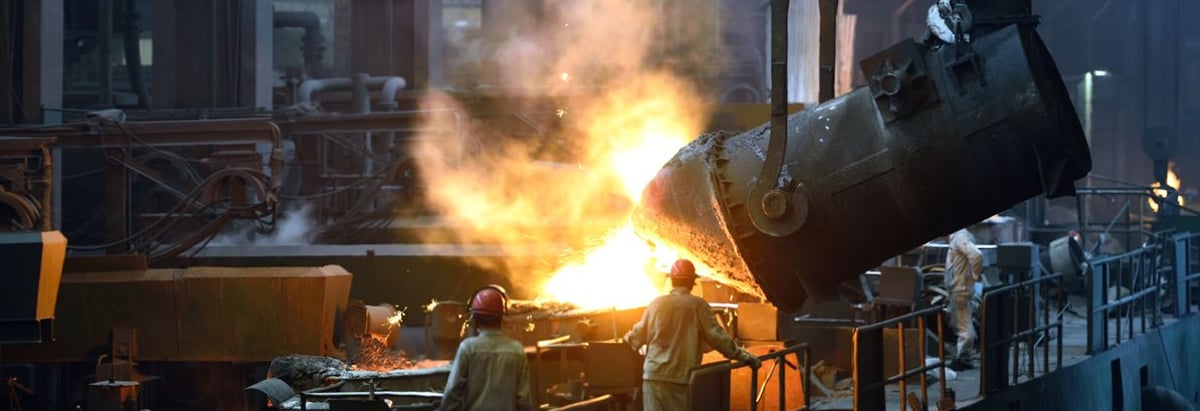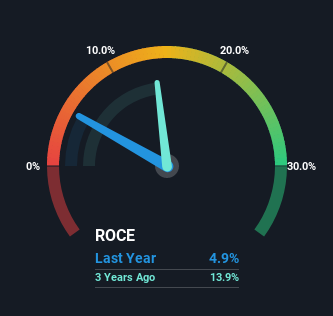- Hong Kong
- /
- Metals and Mining
- /
- SEHK:323
Maanshan Iron & Steel (HKG:323) Could Be At Risk Of Shrinking As A Company

If we're looking to avoid a business that is in decline, what are the trends that can warn us ahead of time? Businesses in decline often have two underlying trends, firstly, a declining return on capital employed (ROCE) and a declining base of capital employed. This reveals that the company isn't compounding shareholder wealth because returns are falling and its net asset base is shrinking. Having said that, after a brief look, Maanshan Iron & Steel (HKG:323) we aren't filled with optimism, but let's investigate further.
Return On Capital Employed (ROCE): What Is It?
For those that aren't sure what ROCE is, it measures the amount of pre-tax profits a company can generate from the capital employed in its business. To calculate this metric for Maanshan Iron & Steel, this is the formula:
Return on Capital Employed = Earnings Before Interest and Tax (EBIT) ÷ (Total Assets - Current Liabilities)
0.049 = CN¥2.2b ÷ (CN¥95b - CN¥51b) (Based on the trailing twelve months to June 2022).
Therefore, Maanshan Iron & Steel has an ROCE of 4.9%. Ultimately, that's a low return and it under-performs the Metals and Mining industry average of 12%.
Check out our latest analysis for Maanshan Iron & Steel

In the above chart we have measured Maanshan Iron & Steel's prior ROCE against its prior performance, but the future is arguably more important. If you'd like to see what analysts are forecasting going forward, you should check out our free report for Maanshan Iron & Steel.
What The Trend Of ROCE Can Tell Us
There is reason to be cautious about Maanshan Iron & Steel, given the returns are trending downwards. About five years ago, returns on capital were 9.5%, however they're now substantially lower than that as we saw above. Meanwhile, capital employed in the business has stayed roughly the flat over the period. Since returns are falling and the business has the same amount of assets employed, this can suggest it's a mature business that hasn't had much growth in the last five years. So because these trends aren't typically conducive to creating a multi-bagger, we wouldn't hold our breath on Maanshan Iron & Steel becoming one if things continue as they have.
On a side note, Maanshan Iron & Steel's current liabilities have increased over the last five years to 54% of total assets, effectively distorting the ROCE to some degree. Without this increase, it's likely that ROCE would be even lower than 4.9%. And with current liabilities at these levels, suppliers or short-term creditors are effectively funding a large part of the business, which can introduce some risks.
The Bottom Line
All in all, the lower returns from the same amount of capital employed aren't exactly signs of a compounding machine. Investors haven't taken kindly to these developments, since the stock has declined 30% from where it was five years ago. That being the case, unless the underlying trends revert to a more positive trajectory, we'd consider looking elsewhere.
If you want to know some of the risks facing Maanshan Iron & Steel we've found 2 warning signs (1 is a bit unpleasant!) that you should be aware of before investing here.
While Maanshan Iron & Steel isn't earning the highest return, check out this free list of companies that are earning high returns on equity with solid balance sheets.
If you're looking to trade Maanshan Iron & Steel, open an account with the lowest-cost platform trusted by professionals, Interactive Brokers.
With clients in over 200 countries and territories, and access to 160 markets, IBKR lets you trade stocks, options, futures, forex, bonds and funds from a single integrated account.
Enjoy no hidden fees, no account minimums, and FX conversion rates as low as 0.03%, far better than what most brokers offer.
Sponsored ContentNew: Manage All Your Stock Portfolios in One Place
We've created the ultimate portfolio companion for stock investors, and it's free.
• Connect an unlimited number of Portfolios and see your total in one currency
• Be alerted to new Warning Signs or Risks via email or mobile
• Track the Fair Value of your stocks
Have feedback on this article? Concerned about the content? Get in touch with us directly. Alternatively, email editorial-team (at) simplywallst.com.
This article by Simply Wall St is general in nature. We provide commentary based on historical data and analyst forecasts only using an unbiased methodology and our articles are not intended to be financial advice. It does not constitute a recommendation to buy or sell any stock, and does not take account of your objectives, or your financial situation. We aim to bring you long-term focused analysis driven by fundamental data. Note that our analysis may not factor in the latest price-sensitive company announcements or qualitative material. Simply Wall St has no position in any stocks mentioned.
About SEHK:323
Maanshan Iron & Steel
Manufactures and sells iron and steel products, and related by-products in Mainland China, Hong Kong, and internationally.
Fair value with moderate growth potential.


